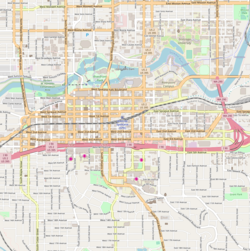
Flushing is a neighborhood in the north-central portion of the New York City borough of Queens. The neighborhood is the fourth-largest central business district in New York City. Downtown Flushing is a major commercial and retail area, and the intersection of Main Street and Roosevelt Avenue at its core is the third-busiest in New York City, behind Times Square and Herald Square.

The Chinatown–International District of Seattle, Washington is the center of the city's Asian American community. Within the district are the three neighborhoods known as Chinatown, Japantown and Little Saigon, named for the concentration of businesses owned by people of Chinese, Japanese and Vietnamese descent, respectively. The geographic area also once included Manilatown.

Chinatown is a neighbourhood in Vancouver, British Columbia, and is Canada's largest Chinatown. Centred around Pender Street, it is surrounded by Gastown to the north, the Downtown financial and central business districts to the west, the Georgia Viaduct and the False Creek inlet to the south, the Downtown Eastside and the remnant of old Japantown to the northeast, and the residential neighbourhood of Strathcona to the southeast.

Interstate 395 (I-395) is an auxiliary Interstate Highway in the US state of Maryland. Known as Cal Ripken Way, the highway runs 1.98 miles (3.19 km) from I-95 north to Howard Street and Camden Street in Downtown Baltimore, where it provides access to the Inner Harbor and the Baltimore Convention Center. The Interstate also serves the Camden Yards Sports Complex, which contains M&T Bank Stadium and Oriole Park at Camden Yards, homes of the Baltimore Ravens and Baltimore Orioles, respectively. I-395 also serves as the southern terminus of Martin Luther King Jr. Boulevard, an urban arterial that provides a western bypass of Downtown Baltimore and connects I-95 with U.S. Route 40 (US 40), US 1, and I-83. The Interstate is maintained by the Maryland Transportation Authority (MDTA) and, like all Interstates, is a part of the National Highway System.
Valley Boulevard is a street in Southern California, running east from Los Angeles to Pomona, where it becomes Holt Avenue, and a continuation from Fontana to Colton. It generally parallels Interstate 10 (I-10) and State Route 60 (CA 60), and is the original alignment of U.S. Route 60 (US 60). The present north end of I-710 is at Valley Boulevard in Los Angeles, just west of Alhambra.
This is an alphabetical index of topics related to Asian Americans.
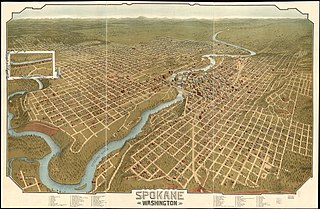
Neighborhoods in Spokane, Washington are officially grouped by the Spokane City Council into three main city council districts: 1, 2, and 3. Each city council district contains multiple, official neighborhoods that are recognized with a neighborhood council. Informally, neighborhoods are colloquially grouped by local geographical, geological, cultural, or historical features The list of neighborhoods below is organized based on the official designations by the City of Spokane. Unofficial neighborhoods and districts are listed within the official neighborhood in which they are located.

Downtown San Diego is the city center of San Diego, California, the eighth largest city in the United States. In 2010, the Centre City area had a population of more than 28,000. Downtown San Diego serves as the cultural and financial center and central business district of San Diego, with more than 4,000 businesses and nine districts. The downtown area is the home of the San Diego Symphony and the San Diego Opera as well as multiple theaters and several museums. The San Diego Convention Center and Petco Park, home of the San Diego Padres, are also located downtown. Downtown San Diego houses the major local headquarters of the city, county, state, and federal governments.

Downtown Spokane or Riverside is the central business district of Spokane, Washington. The Riverside neighborhood is roughly bounded by I-90 to the south, Division Street to the east, Monroe Street to the west and Boone Avenue to the north. The topography of Downtown Spokane is mostly flat except for areas downstream of the Spokane Falls which are located in a canyon; the elevation is approximately 1,900 feet (580 m) above sea level.
The Hip Sing Association or HSA, formerly known as the Hip Sing Tong, is a Chinese-American criminal organization/gang formed as a labor organization in New York City's Chinatown during the early 20th century. The Cantonese name "Hip Sing" translates roughly to "cooperating for success." The Hip Sing Tong, along with their rivals the Four Brothers and the On Leong Tong, would be involved in violent Tong wars for control of Chinatown during the early 1900s. During the 1930s and 1940s, the Hip Sings were involved in drug trafficking operations with the Kuomintang (KMT) and later the Office of Policy Coordination (OPC). They would later establish chapters in Chinese-American communities throughout the United States in major cities such as Chicago, Seattle and San Francisco. Recently some branches have begun to transform back into the legitimate fraternal organization they started as over a century prior.

The history of Spokane, Washington in the northwestern United States developed because Spokane Falls and its surroundings were a gathering place for numerous cultures for thousands of years. The area's indigenous people settled there due to the fertile hunting grounds and abundance of salmon in the Spokane River. The first European to explore the Inland Northwest was Canadian explorer-geographer David Thompson, working as head of the North West Company's Columbia Department. At the nexus of the Little Spokane and the Spokane, Thompson's men built a new fur trading post, which is the first long-term European settlement in Washington state.
Alameda Street is a major north-south thoroughfare in Los Angeles County, California. It is approximately 21 miles in length, running from Harry Bridges Boulevard in Wilmington; and through Carson, Compton, Lynwood, Watts, Florence-Graham, Huntington Park, Vernon and Arts District to Spring and College in Chinatown. For much of its length, Alameda runs through present and former industrial corridors, and is paralleled by Union Pacific Railroad tracks.
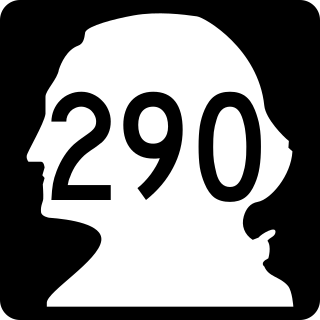
State Route 290 (SR 290), named Hamilton Street and Trent Avenue, is an 18-mile (29 km) long state highway serving Spokane County in the U.S. state of Washington. SR 290 travels parallel to a Union Pacific railroad from Interstate 90 (I-90) in Spokane through Millwood and across the Spokane River thrice towards Spokane Valley, where the highway intersects SR 27. From Spokane Valley, the roadway continues to the Idaho state border, where it becomes Idaho State Highway 53.
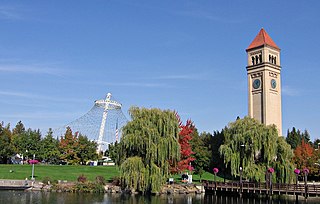
Riverfront Park, branded as Riverfront Spokane, is a public urban park in downtown Spokane, Washington that is owned and operated by the Spokane Parks & Recreation Department. The 100-acre (40 ha) park is situated along the Spokane River and encompasses the Upper Spokane Falls, which is the second largest urban waterfall in the United States.
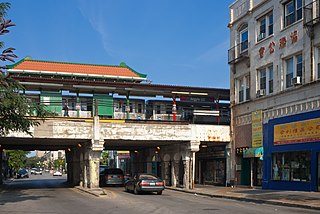
West Argyle Street Historic District is a historic district in northern Uptown, Chicago, Illinois. It was listed on the National Register of Historic Places on June 3, 2010. The community covers an area of about 41 acres (0.17 km2); its rough boundaries are N. Glenwood Ave to the west, Winona Street to the north, Sheridan Road to the east, and Ainslie Street to the south.

Chinatowns are enclaves of Chinese people outside of China. The first Chinatown in the United States was San Francisco's Chinatown in 1848, and many other Chinatowns were established in the 19th century by the Chinese diaspora on the West Coast. By 1875, Chinatowns had emerged in eastern cities such as New York City, Boston, Pittsburgh, and Philadelphia. The Chinese Exclusion Act of 1882 barred Chinese immigration to the United States, but the Magnuson Act of 1943 repealed it, and the population of Chinatowns began to rise again.

The U.S. city of Baltimore, Maryland is home to a small Chinatown. Historically, Baltimore had at least two districts that were called "Chinatown" where the first one existed on the 200 block of Marion Street during the 1880s. A second and current location is at the 300 block of Park Ave., which was dominated by laundries and restaurants. The initial Chinese population came because of the transcontinental railroad, however, the Chinese population never exceeded 400 as of 1941. During segregation, Chinese children were classified as "white" and went to the white schools. Chinatown was largely gone by the First World War due to urban renewal. Although Chinatown was largely spared from the riots of the 1960s, most of the Chinese residents moved to the suburbs. As of 2009, the area still shows signs of blight and does not have a Chinese arch. As of 2017, the area has become an “immigration hub” for Ethiopian people. In 2018, a mural of a Chinese dragon and an African lion was painted to signify the past as a Chinatown and the present as an African neighborhood. A night market in September 2018 marked the first Asian celebration of the area to an area that was “long forgotten and neglected”.
Division Street is a major north–south street in Spokane, Washington, United States. It travels approximately 11 miles (18 km) through a majority of the city, albeit non-contiguously through its southern portions, extending from the South Hill to Spokane's northern border and beyond into Spokane County, where it intersects with the North Spokane Corridor.

Logan is a neighborhood in Spokane, Washington. It is located immediately northeast of Downtown Spokane and is home to Gonzaga University. The Spokane River runs along its eastern and southern edge. Due to its proximity to the city center, Logan is home to some of the oldest and densest areas in the city. It is known for its tree-lined streets, historic buildings and population of college students. In addition to numerous individual properties, there are two historic districts listed on the National Register of Historic Places located within Logan: the Desmet Avenue Warehouse Historic District and the Mission Avenue Historic District.

East Central is a neighborhood in Spokane, Washington. As the name suggests, it is on the east side of Spokane and centrally located. The official neighborhood is expansive and covers multiple areas considered by locals to be independent neighborhoods, such as the Sprague Union District on East Sprague Avenue, the South Perry District, the Underhill Park area and the University District on the eastern fringe of Downtown Spokane.
